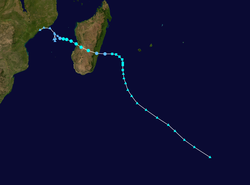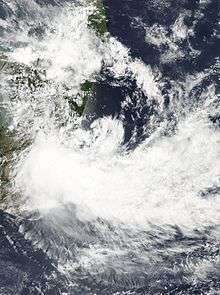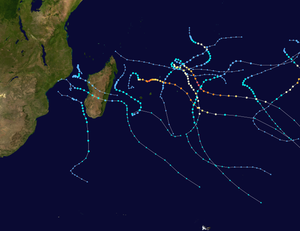Tropical Storm Chedza
Severe Tropical Storm Chedza was a deadly tropical cyclone that struck Madagascar in January 2015. It formed from the intertropical convergence zone and moved over Mozambique, After moving open waters, the system began organizing on January 14, becoming Tropical Storm Chedza two days later. It quickly intensified over the Mozambique Channel due to warm waters and favorable conditions, and the storm attained peak 10 minute sustained winds of 100 km/h (65 mph) on January 16. That day, Chedza moved ashore western Madagascar between Belo sur Mer and Morondava, and it quickly crossed the island while weakening. The storm briefly re-intensified, passing southwest of Réunion before turning to the southeast. Chedza became extratropical on January 19, and was last noted two days later.
| Severe tropical storm (SWIO scale) | |
|---|---|
| Tropical storm (SSHWS) | |
 Satellite image of Chedza approaching Madagascar on January 16 | |
| Formed | January 14, 2015 |
| Dissipated | January 22, 2015 |
| (Extratropical after January 19) | |
| Highest winds | 10-minute sustained: 105 km/h (65 mph) 1-minute sustained: 95 km/h (60 mph) |
| Lowest pressure | 975 hPa (mbar); 28.79 inHg |
| Fatalities | 80 total |
| Damage | $40 million (2015 USD) |
| Areas affected | Zimbabwe, Malawi, Mozambique, Madagascar, Réunion |
| Part of the 2014–15 South-West Indian Ocean cyclone season | |
The formative stages of Chedza brought rainfall to an already flooded region across southeastern Africa. Weeks of heavy rainfall killed 117 people in Mozambique and 104 in neighboring Malawi, where it was the worst floods in 24 years. In Madagascar, Chedza struck after weeks of heavy rainfall, causing rivers to increase and flooding widespread areas of crop fields. In the capital city of Antananarivo, the deluge damaged the main water pump that controlled water levels in the region. The rainfall caused mudslides and damaged roads. Across the country, flooding from Chedza displaced 54,792 people, after destroying 4,430 houses and flooding another 3,442, mostly in Vatovavy-Fitovinany in the southeastern portion. Chedza killed 80 people and caused about $40 million in damage (2015 USD). Later, the storm brought heavy rainfall and strong winds to the mountainous peaks of Réunion.
Meteorological history

An area of convection, or thunderstorms, developed on January 9 within the intertropical convergence zone between the coast of Mozambique and the Mozambique Channel, while moving generally southward.[1] It originated from the same monsoon trough that spawned the powerful Cyclone Bansi.[2] A broad circulation formed within the system on January 12 along the coast of Mozambique,[3] aided by good outflow to the south. Warm sea surface temperatures favored development, although it was located within an area of moderate to high wind shear.[4] On January 14, the Météo-France (MFR) office on Réunion[nb 1] began monitoring the system, labeling it Zone of Disturbed Weather 6 about 170 km (105 mi) east-southeast of Pebane, Mozambique.[6]
A ridge to the north steered the system to the east-southeast. Convection continued to pulse around the system, some of the thunderstorms far from the center,[6] and there were several circulations. The system quickly organized into Tropical Disturbance 6 by 12:00 UTC on January 14 as conditions became more favorable.[7] The thunderstorms continued to fluctuate, exposing the circulation briefly,[8] before the system became much better organized on January 15.[9] Later that day, the disturbance intensified into Tropical Depression 6,[10] and at 00:00 UTC on January 16, the MFR upgraded the system to Tropical Storm Chedza.[11] At the same time, the Joint Typhoon Warning Center (JTWC)[nb 2] began tracking the system as Tropical Cyclone 05S.[13] Despite having intensified into a tropical storm, Chedza initially resembled a monsoon depression. However, strengthening was expected due to low wind shear and the warm waters.[14] The storm quickly intensified while approaching western Madagascar, and the MFR upgraded it to a severe tropical storm with peak 10 minute sustained winds of 100 km/h (65 mph).[15] The convection wrapped into the circulation more as the circulation consolidated and became more defined, prompting the JTWC to estimate peak 1 minute winds of 95 km/h (60 mph).[16] Before 18:00 UTC on January 16, Chedza moved ashore in western Madagascar between Belo sur Mer and Morondava, and it quickly weakened to tropical depression status over land.[17]

At around 10:00 UTC on February 17, Chedza emerged over open waters.[18] By that time, the circulation was slightly exposed with the bulk of the convection along the southern periphery.[19] Later on January 17, Chedza organized and re-intensified into a tropical storm.[20] By contrast, the JTWC ceased issuing advisories on January 18, noting that the storm was dissipating due to increased wind shear.[21] Chedza turned to the southeast toward a trough and continued strengthening. Although the MFR described the structure as "unconventional", the agency estimated a secondary peak of 95 km/h (60 mph).[22] On January 19, the convection became far removed from the center as wind shear increased, and Chedza transitioned into a post-tropical cyclone as it began becoming extratropical.[23] The MFR issued their last advisory on the storm on January 20,[24] and they last noted the storm on the following day moving southward.[25]
Impact

In its formative stages, Chedza moved over Mozambique on January 14,[3][26] producing flooding in the country as well as neighboring Malawi and Zimbabwe.[27]
In Malawi, the formative stages of Chedza brought heavy rainfall that caused deadly floods,[26] following two weeks of precipitation. Widespread flooding covered homes and farmlands in the country's southern portion.[28]
At least 260,000 people were left homeless, and there were 176 fatalities. The Malawian government requested $430 million in international aid to cope with flood recovery.[26] It was the worst flooding in Malawi in 24 years,[28] when floods in 1991 caused $24 million in damage (1991 USD).[26]
When the precursor to Chedza moved over Mozambique, heavy rainfall caused deadly floods that killed 120 people.[26][29]
In western Madagascar, Morondava reported 10 minute winds of 99 km/h (62 mph) while Chedza was making landfall. Ahead of the storm, the MFR anticipated a storm surge of 1 to 2 m (3.3 to 6.6 ft) along the coast.[15] The storm struck after Madagascar was experiencing several weeks of heavy rainfall, with river levels already increased.[30] By early February, much of the country had received twice its average rainfall for the time period.[31] After the storm moved through the region, the Ikopa River reached 4.65 m (15.3 ft) at Bevomanga, above the alert stage of 4.5 m (15 ft).[32] The river fell below alert stage by January 21.[33] The Sisaony River at Ampitatafika reached 1.04 m (3.4 ft).[32] High rains damaged the water pump station in Antananarivo, which controlled water levels in the city; this caused increased flooding and damage along nearby rivers.[34] Across the country, flooding from Chedza displaced another 54,792 people,[35] after destroying 4,430 houses and flooding another 3,442, mostly in Vatovavy-Fitovinany.[35] Chedza damaged or flooded 969 classrooms, disrupting the education of 48,000 students. The storm also damaged 44 health centers and eight district hospitals,[36] with 80 administrative buildings impacted.[37] The floods inundated 9,922 ha (24,520 acres) of fields,[34] including 8,494 ha (20,990 acres) of damaged rice fields, left 1,226 heads of cattle missing.[35] The storm also damaged 42 roads and six bridges,[35] and one dam was damaged.[38] Throughout the country, Chedza killed 80 people,[39] many of whom killed by landslides,[40] and damage was estimated at over 100 billion ariary (US$40 million).[27]
Late in its duration, Chedza spread a plume of moisture across Réunion over three days. Salazie in the mountainous center portion of the island recorded 270 mm (11 in), including 118 mm (4.6 in) in just 12 hours. During the storm's passage to the southwest, Chedza produced peak wind gusts of 90 km/h (56 mph) at Gîte de Bellecombe. The storm also caused high waves along Réunion's west coast, with peak wave of 6.8 m (22 ft).[2]
Aftermath

Malawi president Peter Mutharika declared 15 of the country's 28 districts as disaster areas, mainly in the southern portion.[28] The government requested $430 million worth of international aid to assist in relief efforts.[26] By a month after the worst of the floods in Malawi, the World Food Programme provided meals to 288,000 people.[41]
Immediately following the storm, Madagascar's National Social Insurance Fund provided blankets, soap, candles, and rice to storm victims.[42] Other agencies distributed supplies such as pots, food, tents, and candles.[37] The government set up temporary shelters that housed at least 20,000 people.[34] The floods displaced "untold numbers of rats", according to the World Health Organization, which potentially contributed to the ongoing plague outbreak.[43] The floods began subsiding by the end of January, allowing the displaced residents to return home.[36] In response to the deaths, the Malagasy government ordered flags to be flown at half-mast.[40] On January 28, the government launched a request for international assistance due to the heavy damage.[27] In response, the government of Japan provided ¥17 million (US$142,000) worth of supplies, such as tents and water purifiers.[44]
See also
- Tropical Storm Delfina – Weak storm in 2003 that killed 56 people in Mozambique while moving over land
- Cyclone Haruna – Stronger cyclone in 2013 that took a similar track, killing 26 in Madagascar
Notes
- The Météo-France office in Réunion is the official Regional Specialized Meteorological Center for the basin.[5]
- The Joint Typhoon Warning Center is a joint United States Navy – United States Air Force task force that issues tropical cyclone warnings for the western Pacific Ocean and other regions.[12]
References
| Wikimedia Commons has media related to Cyclone Chedza. |
- Bulletin for Cyclonic Activity and Significant Tropical Weather in the Southwest Indian Ocean (PDF) (Report). La Reunion Tropical Cyclone Center. January 9, 2015. Archived from the original (PDF) on February 8, 2015. Retrieved February 8, 2015.
- "Forte Tempête Tropicale Chedza" (in French). Météo France. 2015. Retrieved February 8, 2015.
- Bulletin for Cyclonic Activity and Significant Tropical Weather in the Southwest Indian Ocean (PDF) (Report). La Reunion Tropical Cyclone Center. January 12, 2015. Archived from the original (PDF) on February 8, 2015. Retrieved February 8, 2015.
- "Significant Tropical Weather Advisory for the Indian Ocean". Joint Typhoon Warning Center. January 12, 2015. Archived from the original on January 15, 2015.
- Worldwide Tropical Cyclone Centers (Report). National Hurricane Center. September 11, 2011. Retrieved January 20, 2015.
- Zone of Disturbed Weather 6 Warning Number 1 (Report). La Reunion Tropical Cyclone Center. Archived from the original on January 14, 2015. Retrieved January 14, 2015.
- Tropical Disturbance 6 Warning Number 2 (Report). La Reunion Tropical Cyclone Center. Archived from the original on January 15, 2015. Retrieved January 14, 2015.
- Tropical Disturbance 6 Warning Number 5 (Report). La Reunion Tropical Cyclone Center. Archived from the original on January 15, 2015. Retrieved January 15, 2015.
- Tropical Disturbance 6 Warning Number 6 (Report). La Reunion Tropical Cyclone Center. Archived from the original on January 16, 2015. Retrieved January 15, 2015.
- Tropical Depression 6 Warning Number 7 (Report). La Reunion Tropical Cyclone Center. Archived from the original on January 16, 2015. Retrieved February 7, 2015.
- Numero: 008/6 (Sud-ouest de L'Ocean Indien) (Report) (in French). La Reunion Tropical Cyclone Center. Archived from the original on January 16, 2015. Retrieved February 7, 2015.
- "Joint Typhoon Warning Center Mission Statement". Joint Typhoon Warning Center. 2011. Archived from the original on 2007-07-26. Retrieved 2012-07-25.
- Tropical Cyclone 06S (Chedza) Warning NR 001 (Report). Joint Typhoon Warning Center. January 16, 2015. Archived from the original on January 17, 2015. Retrieved February 7, 2015.
- Moderate Tropical Storm 6 (Chedza) Warning Number 9 (Report). La Reunion Tropical Cyclone Center. Archived from the original on January 16, 2015. Retrieved February 7, 2015.
- Severe Tropical Storm 6 (Chedza) Warning Number 10 (Report). La Reunion Tropical Cyclone Center. Archived from the original on January 16, 2015. Retrieved February 7, 2015.
- Tropical Cyclone 06S (Chedza) Warning NR 002 (Report). Joint Typhoon Warning Center. January 16, 2015. Archived from the original on January 17, 2015. Retrieved February 7, 2015.
- Numero: 011/6 (Sud-ouest de L'Ocean Indien) (Report) (in French). La Reunion Tropical Cyclone Center. Archived from the original on January 17, 2015. Retrieved February 7, 2015.
- Tropical Depression 6 (ex-Chedza) Warning Number 14 (Report). La Reunion Tropical Cyclone Center. Archived from the original on January 18, 2015. Retrieved February 7, 2015.
- Tropical Cyclone 06S (Chedza) Warning NR 004 (Report). Joint Typhoon Warning Center. January 17, 2015. Archived from the original on January 18, 2015. Retrieved February 7, 2015.
- Moderate Tropical Storm 6 (Chedza) Warning Number 15 (Report). La Reunion Tropical Cyclone Center. Archived from the original on January 18, 2015. Retrieved February 7, 2015.
- Tropical Cyclone 06S (Chedza) Warning NR 005 (Report). Joint Typhoon Warning Center. January 18, 2015. Archived from the original on January 18, 2015. Retrieved February 7, 2015.
- Moderate Tropical Storm 6 (Chedza) Warning Number 18 (Report). La Reunion Tropical Cyclone Center. Archived from the original on January 19, 2015. Retrieved February 7, 2015.
- Post-Tropical Depression 6 (ex-Chedza) Warning Number 22 (Report). La Reunion Tropical Cyclone Center. Archived from the original on January 19, 2015. Retrieved February 8, 2015.
- Warning Number 026/6 (PDF) (Report). La Reunion Tropical Cyclone Center. January 20, 2015. Archived from the original (PDF) on February 8, 2015. Retrieved February 8, 2015.
- Bulletin for Cyclonic Activity and Significant Tropical Weather in the Southwest Indian Ocean (PDF) (Report). La Reunion Tropical Cyclone Center. January 21, 2015. Archived from the original (PDF) on February 8, 2015. Retrieved February 8, 2015.
- Jeff Masters (February 19, 2015). "Second Warmest January on Record Globally". Retrieved February 21, 2015.
- Lovasoa Rabary (January 28, 2015). "Madagascar seeks international aid after tropical storm kills 68". Reuters. Retrieved February 10, 2015.
- Rex Chikoko (January 23, 2015). "Flood-hit Malawi faces aid deficit". Mail and Guardian. Retrieved February 17, 2015.
- Manuel Mucari (January 28, 2015). "Death toll rises as Mozambique weighs up flood costs". Mail & Guardian News. Retrieved February 17, 2015.
- United Nations Office for the Coordination of Humanitarian Affairs (January 16, 2015). "Southern Africa: Floods and Cyclones Update (as of 16 Jan 2015)". ReliefWeb. Retrieved February 8, 2015.
- United Nations Office for the Coordination of Humanitarian Affairs (February 5, 2015). "Flash Update XI: Southern Africa Floods, 5 February 2015". ReliefWeb. Retrieved February 17, 2015.
- "Bulletin hydrologique du 20/01/2015 à 15h". Government of Madagascar (in French). ReliefWeb. January 20, 2015. Retrieved February 10, 2015.
- "Bulletin hydrologique du 21/01/2015 à 15h". Government of Madagascar (in French). ReliefWeb. January 21, 2015. Retrieved February 10, 2015.
- "Madagascar: Cyclone Chedza Emergency Plan of Action (EPoA) Operation n° MDRMG011" (PDF). International Federation of Red Cross And Red Crescent Societies. ReliefWeb. February 2, 2015. Retrieved February 17, 2015.
- National Office of Disaster and Risk Management (February 1, 2015). "Intemperies et Forte Tempete Tropicale "Chedza" Situation à la date du 01 février 2015 - 16H00" (PDF) (in French). ReliefWeb. Retrieved February 17, 2015.
- United Nations Office for the Coordination of Humanitarian Affairs (January 16, 2015). "Madagascar : Saison cyclonique 2014-2015 : Inondation et tempête tropicale Chedza - Rapport de mise à jour n. 13, Jeudi, le 29 janvier 2015" (in French). ReliefWeb. Retrieved February 12, 2015.
- National Office of Disaster and Risk Management (January 26, 2015). "Intemperies et Forte Tempete Tropicale "Chedza" Situation à la date du 26 janvier 2015 - 16H00" (PDF) (in French). ReliefWeb. Retrieved February 9, 2015.
- United Nations Office for the Coordination of Humanitarian Affairs (January 19, 2015). "Tropical Depression Chedza" (PDF). ReliefWeb. Retrieved February 9, 2015.
- "9 February 2015: World Events". European Commission Humanitarian Aid department. ReliefWeb. February 9, 2015. Retrieved February 17, 2015.
- "Madagascar storm death toll climbs to 68". ReliefWeb. Agence France-Presse. January 27, 2015. Retrieved February 10, 2015.
- "One Month Since Malawi's Disaster Declaration". World Food Programme. ReliefWeb. February 20, 2015. Retrieved February 21, 2015.
- "Remise des dons pour les sinistres au palais de Mahazoarivo par la CNAPS". Government of Madagascar. ReliefWeb. January 21, 2015. Retrieved February 10, 2015.
- "Dr. Margaret Chan speech at the opening of the 136th session of the Executive Board". World Health Organization. ReliefWeb. January 26, 2015. Retrieved February 10, 2015.
- "Emergency Assistance to the Republic of Madagascar in response to the Cyclone Disaster". Government of Japan. ReliefWeb. February 12, 2015. Retrieved February 17, 2015.
